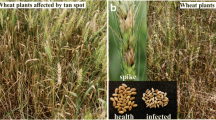Abstract
Tan spot caused by Pyrenophora tritici-repentis is the main foliar diseases of wheat in Brazil. The effect of silicon (Si) on the components of resistance of a susceptible (Fundacep Horizonte) and a moderately resistant (Quartzo) wheat cultivar was studied in a controlled environment. Silicon was supplied as calcium silicate in the soil 30 days before sowing. At the booting stage, a conidial suspension of the fungus was sprayed onto the flag leaves of potted plants, which were incubated under moist conditions for 48 h. Afterwards, inoculated leaves were assessed for: incubation period (IP), infection efficiency (IE), area under lesion size curve (AULSC), lesion size (LS), severity (SEV) and area under severity curve (AUSC). Foliar Si concentrations were quantified at the end of the evaluations. Si supply to plants increased leaf Si concentration in 233% for Fundacep Horizonte (from 4.8 to 16.0 g kg−1 of dry matter) and 211% for Quartzo (from 5.3 to 16.5 g kg−1 of dry matter). In the Si + treatments, IP was longer by 24 and 17 h, IE declined by 53.5 and 65.5%, LS (at 264 h after inoculation) by 4.6 mm (from 9.5 to 4.9 mm) and 5.9 mm (from 8.2 to 2.3 mm), and SEV by 53% (from 54.4 to 18.8%) and 88% (from 47.7 to 5.5%) respectively, for the Fundacep Horizonte and Quartzo cultivars. The Si x cultivar interaction was not significant for AULSC and AUSC, and these variables were reduced by 55.8 and 80.8%, respectively, in plants supplied with Si. In conclusion, Si enhanced the resistance of wheat plants to tan spot development by affecting several resistance components, regardless of the resistance level of the cultivar. However, the greatest reduction in tan spot development by Si supply was observed when using a moderately resistant cultivar.


Similar content being viewed by others
References
Andrie, R. A., Pandelova, L., & Ciuffetti, L. A. (2007). A combination of phenotypic and genotypic characterization strengthens Pyrenophora tritici-repentis race identification. Phytopathology, 97(6), 694–701.
Andrie, R. M., Schoch, C. L., Hedges, R., Spatafora, J. W., & Ciuffetti, L. M. (2008). Homologs of ToxB, a host-selective toxin gene from Pyrenophora tritici-repentis, are present in the genome of sister-species Pyrenophora bromi and other members of the Ascomycota. Fungal Genetics and Biology, 45(3), 363–377.
Bankina, B., Gaile, Z., Balodis, O., Bimsteine, G., Katamadze, M., Kreita, D., Paura, L., & Priekule, I. (2014). Harmful winter wheat diseases and possibilities for their integrated control in Latvia. Acta Agriculturae Scandinavica Section B-Soil and Plant Science, 64(7), 615–622.
Bélanger, R. R., Benhamou, N., & Menzies, J. G. (2003). Cytological evidence of an active role of silicon in wheat resistance to powdery mildew (Blumeria graminis f. Sp tritici). Phytopathology, 93(4), 402–412.
Berger, R. D., Bergamin Filho, A., & Amorim, L. (1997). Lesion expansion as an epidemic component. Phytopathology, 87(10), 1005–1013.
Bockus, W. W., & Claassen, M. M. (1992). Effects of crop-rotation and residue management-practices on severity of tan spot of winter-wheat. Plant Disease, 76(6), 633–636.
Bouktila, D., Khalfallah, Y., Habachi-Houimli, Y., Mezghani-Khemakhem, M., Makni, M., & Makni, H. (2014). Full-genome identification and characterization of NBS-encoding disease resistance genes in wheat. Molecular Genetics and Genomics, 290(1), 257–271.
Cacique, I. S., Domiciano, G. P., Rodrigues, F. A., & Ribeiro do Vale, F. X. (2012). Silicon and manganese on rice resistance to blast. Bragantia, 71(2), 239–244.
Cai, K., Gao, D., Luo, S., Zeng, R., Yang, J., & Zhu, X. (2008). Physiological and cytological mechanisms of silicon-induced resistance in rice against blast disease. Physiologia Plantarum, 134(2), 324–333.
Carmona, M. A., Ferrazini, M., & Barreto, D. E. (2006). Tan spot of wheat caused by Drechslera tritici-repentis: detection, transmission, and control in wheat seed. Cereal Research Communications, 34(2–3), 1043–1049.
Dallagnol, L. J., Rodrigues, F. A., Mielli, M. V. B., Ma, J. F., & Datnoff, L. E. (2009). Defective active silicon uptake affects some components of rice resistance to brown spot. Phytopathology, 99(1), 116–121.
Dallagnol, L. J., Rodrigues, F. A., Da Matta, F. M., Mielli, M. V. B., & Pereira, S. C. (2011). Deficiency in silicon uptake affects cytological, physiological, and biochemical events in the rice-Bipolaris oryzae interaction. Phytopathology, 101(1), 92–104.
Dallagnol, L. J., Rodrigues, F. A., Tanaka, F. A. O., Amorim, L., & Camargo, L. E. A. (2012). Effect of potassium silicate on epidemic components of powdery mildew on melon. Plant Pathology, 61(2), 323–330.
Domiciano, G. P., Rodrigues, F. A., Vale, F. X. R., Xavier Filha, M. S., Moreira, W. R., Lage Andrade, C. C., & Pereira, S. C. (2010). Wheat resistance to spot blotch potentiated by silicon. Journal of Phytopathology, 158(5), 334–343.
Domiciano, G. P., Rodrigues, F. A., Guerra, A. M. N., & Vale, F. X. R. (2013). Infection process of Bipolaris sorokiniana on wheat leaves is affected by silicon. Tropical Plant Pathology, 38(3), 258–263.
Epstein, E. (2009). Silicon: Its manifold roles in plants. Annals of Applied Biology, 155(2), 155–160.
Gremillion, S. K., Culbreath, A. K., Gorbet, D. W., Mullinix Jr., B. G., Pittman, R. N., Stevenson, K. L., Todd, J. W., Escobar, R. E., & Condori, M. M. (2011). Field evaluations of leaf spot resistance and yield in peanut genotypes in the United States and Bolivia. Plant Disease, 95(3), 263–268.
Güevel, M. H., Menzies, J. G., & Bélanger, R. R. (2007). Effect of root and foliar applications of soluble silicon on powdery mildew control and growth of wheat plants. European Journal of Plant Pathology, 119(4), 429–436.
Hayasaka, T., Fujii, H., & Ishiguro, K. (2008). The role of silicon in preventing appressorial penetration by the rice blast fungus. Phytopathology, 98(9), 1038–1044.
Hodson, M. J., White, P. J., Mead, A., & Broadley, M. R. (2005). Phylogenetic variation in the silicon composition of plants. Annals of Botany, 96(6), 1027–1046.
Keane, P. J., & dan Kerr, A. (1997). Factors affecting disease development. In J. F. Brown & H. J. Ogle (Eds.), Plant pathogen and plant disease (pp. 287–298). Armidale: Rockvale Publications.
Kim, S. G., Kim, K. W., Park, E. W., & Choi, D. (2002). Silicon-induced cell wall fortification of rice leaves: a possible cellular mechanism of enhanced host resistance to blast. Phytopathology, 92(10), 1095–1103.
Korndörfer, G., Pereira, H., Nolla, A. (2004). Análise de silício: solo, planta e fertilizante, 2nd edn. Uberlândia: Universidade Federal de Uberlândia.
Large, E. C. (1954). Growth stages in cereals - illustration of the feekes scale. Plant Pathology, 3(4), 128–129.
Ma, J. F. (2004). Role of silicon in enhancing the resistance of plants to biotic and abiotic stresses. Soil Science and Plant Nutrition, 50(1), 11–18.
Mulbah, Q. S., Shimelis, H. A., & Laing, M. D. (2015). Combining ability and gene action of three components of horizontal resistance against rice blast. Euphytica, 206(3), 805–814.
Néri, A. (2013). Reunião da comissão brasileira de pesquisa de trigo e triticale: informações técnicas para trigo e triticale – safra 2013. Londrina: Instituto Agronômico do Paraná.
Parlevliet, J. E. (1979). Components of resistance that reduce the rate of epidemic development. Annual Review of Phytopathology, 17, 203–222.
Rafi, M. M., & Epstein, E. (1999). Silicon absorption by wheat (Triticum aestivum L). Plant and Soil, 211(2), 223–230.
Ranzi, C., & Forcelini, C. A. (2013). Curative sprays of fungicides and their effect on lesion expansion of the wheat tan spot. Ciencia Rural, 43(9), 1576–1581.
Rees, R. G., & Platz, G. J. (1980). The epidemiology of yellow spot of wheat in southern Queensland. Australian Journal of Agricultural Research, 31(2), 259–267.
Rees, R. G., & Platz, G. J. (1983). Effects of yellow spot on wheat - comparison of epidemics at different stages of crop development. Australian Journal of Agricultural Research, 34(1), 39–46.
Reis, E. M., & Casa, R. T. (1996). Doenças do trigo VI - mancha amarela da folha. São Paulo: Bayer S.A.
Reis, E. M., & Casa, R. T. (2007). Doenças dos cereais de inverno – diagnose, epidemiologia e controle. Lages: Graphel.
Resende, R. S., Rodrigues, F. A., Soares, J. M., & Casela, C. R. (2009). Influence of silicon on some components of resistance to anthracnose in susceptible and resistant sorghum lines. European Journal of Plant Pathology, 124(3), 533–541.
Rezende, D. C., Rodrigues, F. A., Carre-Missio, V., Schurt, D. A., Kawamura, I. K., & Korndorfer, G. H. (2009). Effect of root and foliar applications of silicon on brown spot development in rice. Australasian Plant Pathology, 38(1), 67–73.
Rodrigues, F. A., Vale, F. X. R., Datnoff, L. E., Prabhu, A. S., & Korndorfer, G. H. (2003). Effect of rice growth stages and silicon on sheath blight development. Phytopathology, 93(3), 256–261.
Rodrigues, F. A., Jurick, W. M., Datnoff, L. E., Jones, J. B., & Rollins, J. A. (2005). Silicon influences cytological and molecular events in compatible and incompatible rice-Magnaporthe grisea interactions. Physiological and Molecular Plant Pathology, 66(4), 144–159.
Rodrigues, F. A., Dallagnol, L. J., Duarte, H. S. S., & Datnoff, L. E. (2015a). Silicon control of foliar diseases in monocots and dicots. In F. A. Rodrigues & L. E. Datnoff (Eds.), Silicon and plant diseases (pp. 67–108). New York: Springer.
Rodrigues, F. A., Resende, R. S., Dallagnol, L. J., & Datnoff, L. E. (2015b). Silicon potentiates host defense mechanisms against infection by plant pathogens. In F. A. Rodrigues & L. E. Datnoff (Eds.), Silicon and plant diseases (pp. 109–138). New York: Springer.
Ronis, A., Semaskiene, R., Dabkevicius, Z., & Liatukas, Z. (2009). Influence of leaf diseases on grain yield and yield components in winter wheat. Journal of Plant Protection Research, 49(2), 151–157.
Seebold, K. W., Kucharek, T. A., Datnoff, L. E., Correa-Victoria, F. J., & Marchetti, M. A. (2001). The influence of silicon on components of resistance to blast in susceptible, partially resistant, and resistant cultivars of rice. Phytopathology, 91(1), 63–69.
Shaner, G., & Finney, R. E. (1977). Effect of nitrogen-fertilization on expression of slow-mildewing resistance in knox wheat. Phytopathology, 67(8), 1051–1056.
Takahashi, E., Ma, J. F., & Miyake, Y. (1990). The possibility of silicon as an essential element for higher plants. Comments on Agricultural and Food Chemistry, 2(2), 99–122.
Vale, F. X. R., Fernandes Filho, E. I., Liberato, J. R. (2003). A software plant disease severity assessment. In: 8th international congress of plant pathology. Anais. Christchurch, New Zealand. p. 105.
Van der Plank, J. E. (1963). Plant diseases: epidemics and control. New York: Academic Press.
Xavier Filha, M. S., Rodrigues, F. A., Domiciano, G. P., Oliveira, H. V., Silveira, P. R., & Moreira, W. R. (2011). Wheat resistance to leaf blast mediated by silicon. Australasian Plant Pathology, 40(1), 28–38.
Acknowledgments
P. C. Pazdiora and K. R. Dorneles received scholarships from Coordenação de Aperfeiçoamento de Pessoal de Ensino Superior (CAPES). L. J. Dallagnol and E. M. Del Ponte are supported by fellowships from Conselho Nacional de Desenvolvimento Científico e Tecnológico (CNPq). This research was supported by a grant from CNPq (476852/2012-9).
Author information
Authors and Affiliations
Corresponding author
Ethics declarations
Conflict of interest
There is no conflict of interest.
Additional information
The manuscript was only submitted to EJPP and not previously published. All authors contributed and agreed to submission to EJPP.
Rights and permissions
About this article
Cite this article
Pazdiora, P.C., da Rosa Dorneles, K., Forcelini, C.A. et al. Silicon suppresses tan spot development on wheat infected by Pyrenophora tritici-repentis . Eur J Plant Pathol 150, 49–56 (2018). https://doi.org/10.1007/s10658-017-1251-4
Accepted:
Published:
Issue Date:
DOI: https://doi.org/10.1007/s10658-017-1251-4




